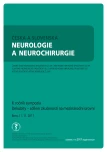The Skin Lesions as a Complications of Parkinson’s Disease
Authors:
J. Búřil 1; P. Búřilová 2
Authors‘ workplace:
I. neurologická klinika
LF MU a FN u sv. Anny v Brně
1; Ústav zdravotnických informací
a statistiky ČR, Praha
2
Published in:
Cesk Slov Neurol N 2017; 80(Supplementum 1): 50-53
Category:
Original Paper
doi:
https://doi.org/10.14735/amcsnn2017S50
Overview
Aim:
We aimed to describe the incidence of pressure lesions (L89) and granulomatous lesion of the skin and subcutaneous tissues (L92) in the selected group of patients with Parkinson‘s disease (PD) (G20).
Material and methods:
We performed a retrospective analysis of data of Parkinson‘s disease patients from hospital information system from the year 2016. Parkinson‘s disease patients were followed in an outpatient Movement Disorder Centre of St. Anne’s University University Hospital in Brno.
Results:
We found 24 patients (3.1%) with pressure lesions and 16 patients (2.1%) with hypergranulations in postoperative scar in place of PEG insertion out of 776 patients (with 3,158 examinations during a selected period) data points. All patients included in the study had a main diagnosis of PD ranging from early form of the disease to a late stage with motor fluctuations and symptoms present (70%). In 94% of patients who suffered from pressure lesions we found partial or complete immobility.
Conclusion:
The incidence of pressure lesions was quite low, which can be cause either by low incidence or by methodological issues on a local level, or by a loss of data from institutional follow up care or home care. We have also found certain level of complications in patients treated by intradudodenal application of L DOPA, i.e. granulations in the skin opening at the point of PEG tube insertion.
Key words:
Parkinson‘s disease – skin lesions – pressure lesions – granulomatosis lesions – complications
The authors declare they have no potential conflicts of interest concerning drugs, products, or services used in the study.
The Editorial Board declares that the manuscript met the ICMJE “uniform requirements” for biomedical papers.
Sources
1. Pfeiffer RF, Wszolek ZK, Ebadi M. Parkinson‘s Disease. 2nd ed. CRC Press 2012:14– 6.
2. Tarakad A, Jankovic J. Diagnosis and Management of Parkinson‘s Disease. Semin Neurol 2017;37(2):118– 26. doi: 10.1055/ s-0037-1601888.
3. National Institue of Neurological Disorders and Stroke. Parkinson‘s Disease Information Page 2017. [online]. Available from URL: https:/ / www.ninds.nih.gov/ Disorders/ All-Disorders/ Parkinsons-Disease-Information-Page.
4. Menšíková K, Bareš M, Kaňovský P, et al. Atypické parkinsonské syndromy. Praha: Galén 2015:13– 21.
5. Majkusová K, Jarošová D. Falls risk factors in an acute – care setting: a retrospective study. Cent Eur J Nurs Midwifery 2014;5(2):47– 53.
6. Jurásková D. Pády a zranění pacientů v souvislosti s poskytováním zdravotní a sociální péče. Ošetřovatelství teorie a praxe moderního ošetřovatelství 2008;10(34):58– 75.
7. Bareš M, Kianička B. Léčba Parkinsonovy nemoci. Neurol Praxi 2014;15(2):105– 8.
8. Leibson CL, Maraganore DM, Bower JH, et al. Comorbid conditions associated with Parkinson’s disease: a population-based study. Mov Disord 2006;21(4):446– 55.
9. Goetz CG, Tilley BC, Shaftman SR, et al. Movement Disorder Society-sponsored revision of the unified Parkinson’s Disease Rating Scale (MDS-UPDRS): scale presentation and clinimetric testing results. Mov Disord 2008;23(15):2129– 70. doi: 10.1002/ mds.22340.
10. Goetz CG, Poewe W, Racol O, et al. Movement Disorder Society Task Force report on the Hoehn and Yahr staging scale: status and recommendations. Mov Disord 2004;9(9):1020– 8. doi: 10.1002/ mds.20213.
11. Sorbi S, Hort J, Erkinjuntti T, et al. EFNS-ENS Guidelines on the diagnosis and management of disorders associated with dementia. Eur J Neurol 2012;19(9):1159– 79. doi: 10.1111/ j.1468-1331.2012.03784.x.
12. National Parkinson Foundation. Parkinson’s DiseaseOverview 2016. [online]. Available from URL: www.parkinson.org/ parkinson-s-disease.aspx.
13. Henchcliffe C, Severt WL. Disease modification in Parkinson’s disease. Drugs Aging 2011;28(8):605– 15. doi: 10.2165/ 11591320-000000000-00000.
14. Kolektiv autorů. Parkinsonova nemoc z různých pohledů. Společnost Parkinson, Praha 2013. [online]. Dostupné z URL: http:/ / parkinson-help.cz/ tiskova-zprava-2/ .
15. Pokorná A, Benešová K, Mužík J, et al. Sledování dekubitálních lézí u pacientů s neurologickým onemocněním – analýza Národního registru hospitalizovaných. Cesk Slov Neurol N 2016;79(Suppl 1):S8– 14. doi: 10.14735/ amcsnn2016S8.
16. Fischer M, Gemende I, Marsch W, et al. Skin function and skin disorders in Parkinson’s Disease. J Neur Trans 2001;108(2):205– 13.
17. Beitz JM. Skin and wound issues in patients with Parkinson’s disease: an overview of common disorders. Ostomy Wound Manage 2013;59(6):26– 36.
18. Průzkum agentury STEM/ MARK pro Parkinson – Help, o.s., březen 2015. [online]. Dostupné z URL: http:/ / parkinson-help.cz/ tiskova-zprava-2/ .
19. Pokorná A, Benešová K, Jarkovský J, et al. PressureInjuries in Inpatient Care Facilities in the Czech Republic: Analysis of a National Electronic Database. J WoundOstomy Continence Nurs 2017;44(4):1– 5. doi: 10.1097/ WON.0000000000000344.
Labels
Paediatric neurology Neurosurgery NeurologyArticle was published in
Czech and Slovak Neurology and Neurosurgery

2017 Issue Supplementum 1
- Metamizole vs. Tramadol in Postoperative Analgesia
- Memantine in Dementia Therapy – Current Findings and Possible Future Applications
- Memantine Eases Daily Life for Patients and Caregivers
- Metamizole at a Glance and in Practice – Effective Non-Opioid Analgesic for All Ages
- Advances in the Treatment of Myasthenia Gravis on the Horizon
Most read in this issue
- Validaton of Nursing Diagnosis of Acute and Chronic Pain According to NANDA International in the Patients with Wound
- Employment of Flap Surgery in Pressure Ulcers Surgical Treatment
- Differential Diagnosis in Pressure Ulcers and Medical Devices
- Pressure Ulcers Represents a Constant Nightmare for Me
